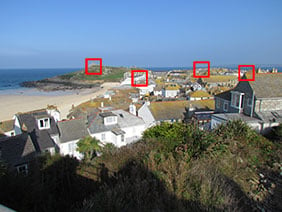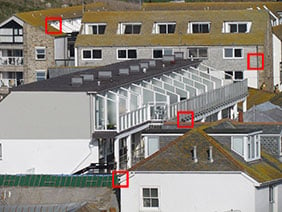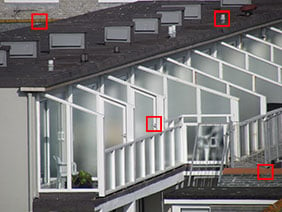Canon PowerShot SX30 IS
-
-
Written by Gordon Laing
Quality
Canon PowerShot SX30 IS vs Panasonic Lumix FZ45 / FZ40 vs Lumix FZ100 Real-life resolution (wide)
Canon PowerShot SX30 IS results : Real-life resolution / Sharpness mid-range / Sharpness telephoto / High ISO Noise
Canon PowerShot SX30IS |
Panasonic Lumix FZ45 / FZ40 |
Panasonic Lumix FZ100 | ||
 |  |  | ||
f4, 80 ISO |
f4, 80 ISO |
f4, 100 ISO | ||
 |  |  | ||
f4, 80 ISO |
f4, 80 ISO |
f4, 100 ISO | ||
 |  |  | ||
f4, 80 ISO |
f4, 80 ISO |
f4, 100 ISO | ||
 | 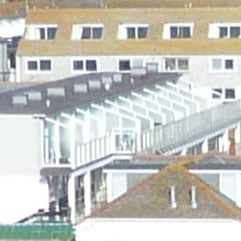 | 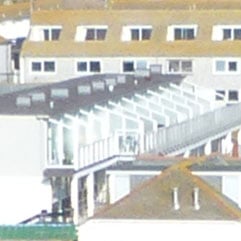 | ||
f4, 80 ISO |
f4, 80 ISO |
f4, 100 ISO |
Canon PowerShot SX30 IS results : Real-life resolution / Sharpness mid-range / Sharpness telephoto / High ISO Noise
All three cameras were set to Program mode at the lowest available ISO sensitivity – 80 ISO on the PowerShot SX30 IS and Lumix FZ45 / FZ40, and 100 ISO on the Lumix FZ100. The above image was taken with the PowerShot SX30 IS in Program mode. The lens was set to 4.3 mm (24mm equivalent) and evaluative metering selected an exposure of 1/800th of a second at f4 at an ISO setting of 80. The original 4320 × 3240 pixel image had a file size of 3.55MB. This test image was shot in bright early autumn sunshine and poses a demanding challenge for auto exposure systems, but the PowerShot SX30 IS has coped very well. The dynamic range in the scene is a little too wide for the PowerShot SX30 IS to avoid either clipping the highlights or losing some detail in the shadows and it’s opted for the former. The histogram shows all the shadow detail has been recorded but there’s a spike on the right side and you can see evidence of a small amount of lost detail in the brightest highlights of the white walls. Overall though, this is a good exposure, the colour balance is within acceptable limits and the colours are well saturated and natural looking. Now let’s look at the detailed crops. The most obvious problem for the PowerShot SX30 IS is chromatic aberration. There’s evidence of magenta/green fringing pretty much throughout the frame, though it gets noticeably worse towards the edges and is particularly intrusive in the third crop. There’s really not a lot you can do about this other than correct it in an image editor. Sometimes reducing the aperture can help eliminate problems caused by lens aberrations, but our tests at smaller apertures showed fringing to the same extent. Aside from the fringing, the overall image quality as seen in the crops is pretty good. Detail is well defined, edges are sharp, and the Digic 4 processor has done its job without leaving behind tell-tale evidence of digital processing. The images aren’t as sharp and detailed as they might be though, and there’s an overall softness which, like the fringing, gets worse as you move out to the periphery of the frame. Given the extraordinary range of the PowerShot SX30 IS zoom lens, we’d say this is a good result in image quality terms, let down only by slight softness and the degree and extent of fringing. The Panasonic Lumix FZ45 / FZ40 comes out of a comparison with the PowerShot SX30 IS fairly well. Firstly, the Lumix FZ45 / FZ40 deals with fringing much more effectively. Like its predecessors, the FZ45 / FZ40 does a good job at removing most of it in-camera for JPEGs, but even when you examine their uncorrected RAW files, they suffer from less fringing than the SX30 IS to start with. So it has less of a problem in the first place and what there is has been effectively removed by processing in-camera. Fine detail looks a little softer and less well defined than in the PowerShot SX30 IS crops. In all four crops we’d say the PowerShot SX30 IS has the edge. Finally, there’s the issue of exposure. The Panasonic Lumix FZ45 / FZ40 overexposed the scene slightly resulting in blown highlights. The histogram is cut off on the right with a gap on the left, showing that a shorter exposure could have retained more of the highlights without sacrificing shadow detail. Perhaps unsurprisingly, the Lumix FZ100 also lacks, for the same reasons, the purple fringing evident in the PowerShot SX30 IS crops. But if the Lumix FZ45 / FZ40 crops are softer than those of the PowerShot SX30 IS, the Lumix FZ100 crops are softer still. And, like it’s sibling, the Lumix FZ100 has overexposed the shot, blowing the highlight detail. Were it not for the fringing, we have no hesitation in saying the PowerShot SX30 IS crops are superior. As it is, if you had to choose between the lesser of two evils, at least the fringing can be easily dealt with in an image editor. Wide angle performance is only part of the story though, for the full picture make sure to take a look at our mid-range resolution and telephoto resolution test pages before seeing how they compare at higher sensitivities in our High ISO Noise results. |
Canon PowerShot SX30 IS vs Panasonic Lumix FZ45 / FZ40 vs Lumix FZ100 Real-life resolution (approx 300mm)
Canon PowerShot SX30 IS results : Real-life resolution / Sharpness mid-range / Sharpness telephoto / High ISO Noise
Canon PowerShot SX30 IS |
Panasonic Lumix FZ45 / FZ40 |
Panasonic Lumix FZ100 | ||
 | 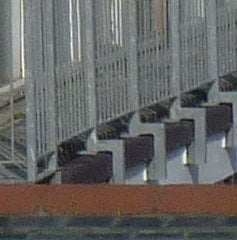 |  | ||
56.1mm (313mm) f5, 80 ISO |
48.8mm (271mm) f4, 80 ISO |
47.5mm (264mm) f4.5, 100 ISO | ||
 |  |  | ||
56.1mm (313mm) f5, 80 ISO |
48.8mm (271mm) f4, 80 ISO |
47.5mm (264mm) f4.5, 100 ISO | ||
 |  |  | ||
56.1mm (313mm) f5, 80 ISO |
48.8mm (271mm) f4, 80 ISO |
47.5mm (264mm) f4.5, 100 ISO | ||
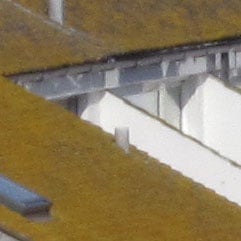 | 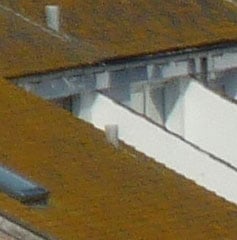 |  | ||
56.1mm (313mm) f5, 80 ISO |
48.8mm (271mm) f4, 80 ISO |
47.5mm (264mm) f4.5, 100 ISO |
Canon PowerShot SX30 IS results : Real-life resolution / Sharpness mid-range / Sharpness telephoto / High ISO Noise
All three cameras were set to Program mode at the lowest available ISO sensitivity – 80 ISO on the PowerShot SX30 IS and Lumix FZ45 / FZ40, and 100 ISO on the Lumix FZ100. The above image was taken with the PowerShot SX30 IS in Program mode. The lens was set to 56.1 mm (313mm equivalent) and the metering selected an exposure of 1/1000th of a second at f5 with an ISO setting of 80. The original 4320 × 3240 pixel image had a file size of 3.7MB. Predictably, the mid-range results from the PowerShot SX30 IS are a significant improvement on those shot at the extremes of the zoom range. The biggest problem, fringing caused by chromatic abberation, has all but disappeared and fine detail looks to be better resolved. These crops are generally crisper and punchier than those from the wide angle and telephoto ends of the zoom range. While it’s great to have a super-zoom with such huge range, without a doubt, if you want to get the best from the PowerShot SX30 IS lens it pays to stay away from the extremes if you can. In a reversal of the situation with the wide angle crops, the Lumix FZ45 / FZ40 turns in a sharper, more contrasty result than the PowerShot SX30 IS. But if you look closely at the crops there is a granular, noisy quality to them and it doesn’t look as if the Lumix FZ45 / FZ40 lens is actually resolving any more detail than that of the PowerShot SX30 IS. Despite the fact that it was shot at the lowest ISO sensitivity setting of 80, the crops from the Lumix FZ45 /FZ4 actually look like they are from a higher ISO image. The crops from the Lumix FZ100 share the granular look of those from the Lumix FZ45 / FZ40, but they lack the edge contrast and look very soft in comnparison to those of both its stablemate and the PowerShot SX30 IS. Take a look at the detail in the vertical bars of the balcony rail in the first crop, the brickwork in the second and the roof tiles in the fourth and final crop, in each of them the Lumix FZ100 comes last in terms of the amount of detail you can make out. If you haven’t done so already, be sure to take a look at our wide-angle resolution and telephoto resolution test pages before seeing how they compare at higher sensitivities in our High ISO Noise results. |
Canon PowerShot SX30 IS vs Panasonic Lumix FZ45 / FZ40 vs Lumix FZ100 Real-life resolution (telephoto)
Canon PowerShot SX30 IS results : Real-life resolution / Sharpness mid-range / Sharpness telephoto / High ISO Noise
Canon PowerShot SX30 IS |
Panasonic Lumix FZ45 / FZ40 |
Panasonic Lumix FZ100 | ||
 | 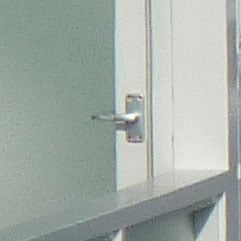 | 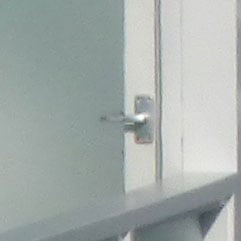 | ||
150.5mm (840mm) f5.8, 80 ISO |
108mm (600mm) f5.2, 80 ISO |
108mm (600mm) f5.2, 100 ISO | ||
 |  |  | ||
150.5mm (840mm) f5.8, 80 ISO |
108mm (600mm) f5.2, 80 ISO |
108mm (600mm) f5.2, 100 ISO | ||
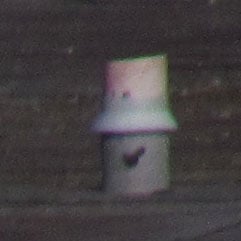 | 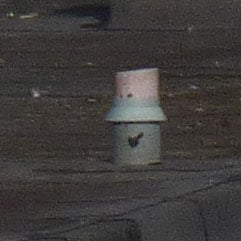 | 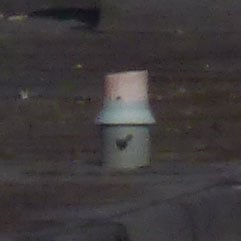 | ||
150.5mm (840mm) f5.8, 80 ISO |
108mm (600mm) f5.2, 80 ISO |
108mm (600mm) f5.2, 100 ISO |
Canon PowerShot SX30 IS results : Real-life resolution / Sharpness mid-range / Sharpness telephoto / High ISO Noise
All three cameras were set to Program mode at the lowest available ISO sensitivity – 80 ISO on the PowerShot SX30 IS and the Lumix FZ45 / FZ40 and 100 ISO on the Lumix FZ100. The above image was taken with the PowerShot SX30 IS in Program mode. The lens was set to 150.5 mm (840mm equivalent) and the metering selected an exposure of 1/800th of a second at f5.8 with an ISO setting of 80. The original 4320 × 3240 pixel image had a file size of 3.27MB. If you’ve already seen the wide-angle and mid-range test results for the PowerShot SX30 IS you’ll know that its biggest problem at the wide-angle zoom setting is fringing caused by chromatic aberration, but this more or less disappears at the mid-range focal lengths. The bad, though perhaps not entirely unexpected, news is that it makes an unwelcome return at the extreme telephoto end of the range. As before, it get worse at the edges of the frame but is clearly in evidence just about everywhere. In the crops below you can see it most clearly in all but the first one. With that one exception the quality of the crops from the PowerShot SX30IS at the 840mm telephoto end of the zoom range is very good indeed, paticularly in the central region of the frame. As you can see in the first crop the lens has resolved the fine detail extremely well and you can make out the screws on door handle quite clearly. Towards the edges detail is less clearly defined but, all things considered, and if you can live or deal with the chromatic aberration, this is a more than acceptable performance from a lens with an extraordinary range. If you were to judge on the first crop alone you might be tempted to think the Lumix FZ45 / FZ40 beats the PowerShot SX30 IS hands down for quality at the telephoto end of the range. But scan down the other crops and you’ll discover that the granularity evident in the wide-angle and mid-range shots is here to an even greater degree. While they’re free of the PowerShot SX30 IS’s worst fault, fringing, these crops look like they’ve been the victim of over-zealous in-camera processing. The Lumix FZ100 results at this end of the zoom range largely bear out what we’ve seen elsewhere. The Lumix FZ100 image quality isn’t poor, far from it, but by comparison with the PowerShot SX30 IS the test image is soft and much of the fine detail is lost. This is most clearly evident in the last of the four crops below. If you haven’t done so already, be sure to take a look at our wide-angle resolution and mid range resolution test pages before seeing how they compare at higher sensitivities in our High ISO Noise results. |
Canon PowerShot SX30 IS vs Panasonic Lumix FZ45 / FZ40 vs Lumix FZ100 High ISO Noise
Canon PowerShot SX30 IS results : Real-life resolution / Sharpness mid-range / Sharpness telephoto / High ISO Noise
Canon PowerShot SX30 IS results : Real-life resolution / Sharpness mid-range / Sharpness telephoto / High ISO Noise
|
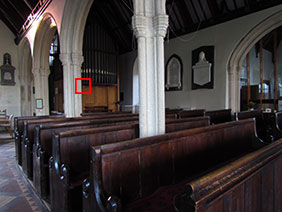 | To compare noise levels under real-life conditions we shot this scene with the Canon PowerShot SX30 IS, the Panasonic Lumix FZ45 / FZ40 and the Panasonic Lumix FZ100. The lenses on all three cameras were set to approximate the same field of view and ISO was manually set. |
The above shot was taken with the the Canon PowerShot SX30 IS in Program mode with the lens at a wide angle setting of 4.3mm (24mm). The ISO sensitivity was set to 80 and the exposure was 0.8 of a second at f2.7. The crops are taken from the area marked with the red square and presented below at 100%.
Though it’s not noise-related, we shouldn’t ignore the fact that chromatic aberration in the form of a thin green halo down the right edge of the stone column continues to be a problem in these high ISO crops. Leaving that aside, the PowerShot SX30 IS demonstrates the kind of noise footprint that we’ve seen previously from Canon models – very little if any visible noise at the lower ISO sensitivities with the amout of noise present at each increased ISO sensitivity rising in a fairly linear fashion. On thing that isn’t typical however is that there does appear to be a visible difference between the 80 and 100 ISO setting. There’s a slight graininess to the wooden panelling in the 100 ISO crop that isn’t there in the 80 ISO one.This is pretty marginal though, and you have to be looking for it to notice it.
Moving up the scale to 200 ISO things are still looking very good, but there is a step-change. The vertical grooves in the wood panelling aren’t so clearly defined and some of the detail in the stone column is beginning to look a little smoothed. At 400 ISO there’s further evidence of smoothing but despite the obvious noise reduction that’s going on it isn’t effective enough to prevent an emerging clumpiness. At 800 ISO we’re well and truly into noise territory – even at low magnificatons in print and on screen this will look umistakeably like a high ISO shot and 1600 ISO is definitely one to save for very special situations.
Generally this is a good performance from the PowerShot SX30 IS, though we can’t help but feel a little disappointed at the early onset of visible noise. By comparison, the results from the Pansonic Lumix FZ45 / FZ40 bear up very well. From 80 to 200 ISO there’s very little to differentiate between the two sets of crops, in fact the Lumix FZ45 / FZ40 100 ISO crop looks less noisy than the PwerShot SX30 IS’s. At 200 and 400 ISO there are minor qualitative differences, but nothing that could be said to be better in one or the other, and so it goes all the way up to 1600 ISO.
As with our outdoor tests, the Lumix FZ100 crops are all marred by an overwhelming softness that smears away all the fine detail. Take a look at the vertical grooves in the panelling of the 100 ISO crop, they’re indistinct at the top and blur away into nothing at the bottom. At 400 ISO the grooves have disappeard into a clumpy regularity – though they are still clearly visible in the PowerShot SX30 IS and Lumix FZ45 / FZ40 crops.
One thing worth noting is that all of these cameras produce a better result in their lower resolution low light scene modes than they do at the full resolution 1600 ISO sensitivity, something worth bearing in mind if image size isn’t a big consideration. Here, the Lumix models have a slight advantage, producing a 3 Megapixel image measuring 2048 × 1536 pixels against a 2 Megapixel 1600 × 1200 image from the PowerShot SX30 IS. Now head over to our Canon PowerShot SX30 IS gallery to see some more real-life shots in a variety of conditions.
Canon PowerShot SX30 IS |
Panasonic Lumix FZ45 / FZ40 |
Panasonic Lumix FZ100 | ||
 |  | |||
80 ISO |
80 ISO |
80 ISO Not available | ||
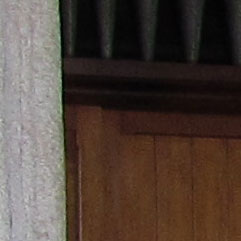 |  |  | ||
100 ISO |
100 ISO |
100 ISO | ||
 |  |  | ||
200 ISO |
200 ISO |
200 ISO | ||
 |  |  | ||
400 ISO |
400 ISO |
400 ISO | ||
 |  |  | ||
800 ISO |
800 ISO |
800 ISO | ||
 | 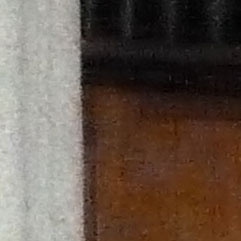 |  | ||
1600 ISO |
1600 ISO |
1600 ISO | ||
 |  | 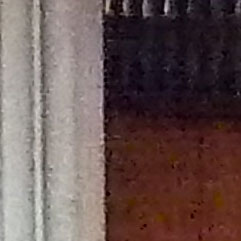 | ||
2500 ISO (Low Light scene mode) |
3200 ISO (High Sens scene mode) |
3200 ISO (High Sens scene mode) |
